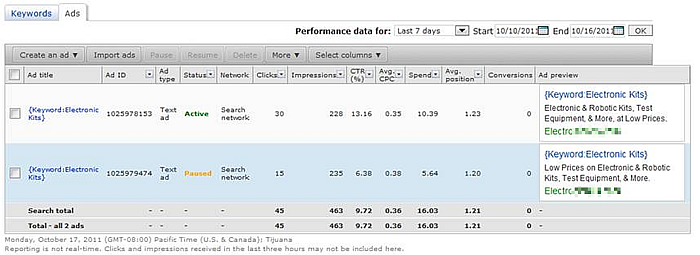A lot of physicians and other business owners are scared of Pay-Per-Click advertising.
It’s true that you can take a terrible beating in a very short time if you’re not careful and don’t know what you’re doing.
On the other hand, properly used, it can be a remarkably effective and remarkably low-cost advertising solution. Yes, it’s gotten more expensive and more competitive than it was, but done right, it still works very well.
Here’s the thing – Google Adwords™ and Microsoft AdCenter™ (the dominant Pay-Per-Click platforms) are promoted as being easy to use.
In a sense that’s true. You can sign up for an account, and put up an ad in a matter of a few minutes.
That’s where people can get in trouble if they don’t understand the intricacies, and especially the importance of setting a budget so that Google or Microsoft don’t spend more of your money than you want.
On the other hand, Pay-Per-Click is a fiendishly complex beast, capable of amazing and subtle refinements, and not at all easy to master. Not only that, it changes all the time, and gets things added to it all the time, so it’s difficult to stay on top of.
That’s why true experts in Pay-Per-Click (PPC) can charge a lot of money to design and run a campaign.
A company doing any kind of serious volume of PPC may well find that an expert can cut their costs in half or double their clicks (and business), or both, and pay his fees with the savings.
Here’s an example on the Microsoft Platform (click on the picture to see a larger, easier-to-read version):

These minor differences can make you or break you…it is all about testing and continuous improvement!
This graphic shows the results of a split-test pitting two ads against each other. Working from the right hand edge, notice that the two ads have the same headline.
Not to get too technical, but this is an example of “Dynamic Keyword Insertion,” a powerful, but tricky PPC tool. The headline will be whatever the searcher typed into the search box, if it’s 25 characters or less, otherwise the headline will be “Electronic Kits.”
The last line, which we’ve partially blurred so as not to embarrass anyone, and which tells you where you’re going if you click the ad, is exactly the same in both ads.
The body copy says just about exactly the same thing in both ads, it just says it a tiny bit differently.
In the “Avg. position” column, we see that the two ads have a virtually identical position on the page. Rounding off, they both are in average position 1.2, so the position on the page didn’t influence the number of clicks the ads received.
Here’s what’s fascinating: Look at the “CTR” column. (CTR stands for “Click Through Ratio”, which is the ratio of the number of times the ad was clicked on compared to the number of times it was displayed.)
We see that one ad was clicked on over 13 times for every 100 times it was shown, while the other ad was clicked on less than 6 and a half times for every 100 times it was shown.
That’s a huge difference! It means that one ad will generate clicks at a substantially lower cost than the other ad. (It’s a very complex pricing model, but the higher/better the CTR, the less you pay. This example doesn’t illustrate that part of it, as we were testing higher bids on the lower-performing ad.)
And for those of you who notice that it’s a fairly limited test… A commonly-used statistical tool to analyze such things says that there are enough impressions and clicks that we can have 99% confidence that the two ads will maintain that huge difference in performance over a long period of time.
This isn’t an isolated example. We’ve seen cases where an ad with an exclamation point significantly out-pulled the same ad with a period.
Sometimes capitalizing one word, or adding a comma, or writing the body copy so the break between lines is at a different place, can make a big difference.
The takeaway is that Pay-Per-Click advertising shouldn’t be scary. Just don’t rush in without a little study, and be careful, or get expert help.
There’s another way to think about and use PPC advertising that isn’t often talked about, and maybe should be done even before you start thinking about your keywords, or your website or blogging or article marketing or promotional campaign or even adding a new procedure.
Stay tuned—I’ll do a post about it soon. I think you’ll find it interesting.
Now back to guarding the front porch against ghouls and ghosts and goblins. A lot of candy ought to do it, right?
Since this is the night for it, tell me your biggest PPC horror story below in the comments!
Scott
Fine print: All trademarks used herein are the property of their respective owners.
